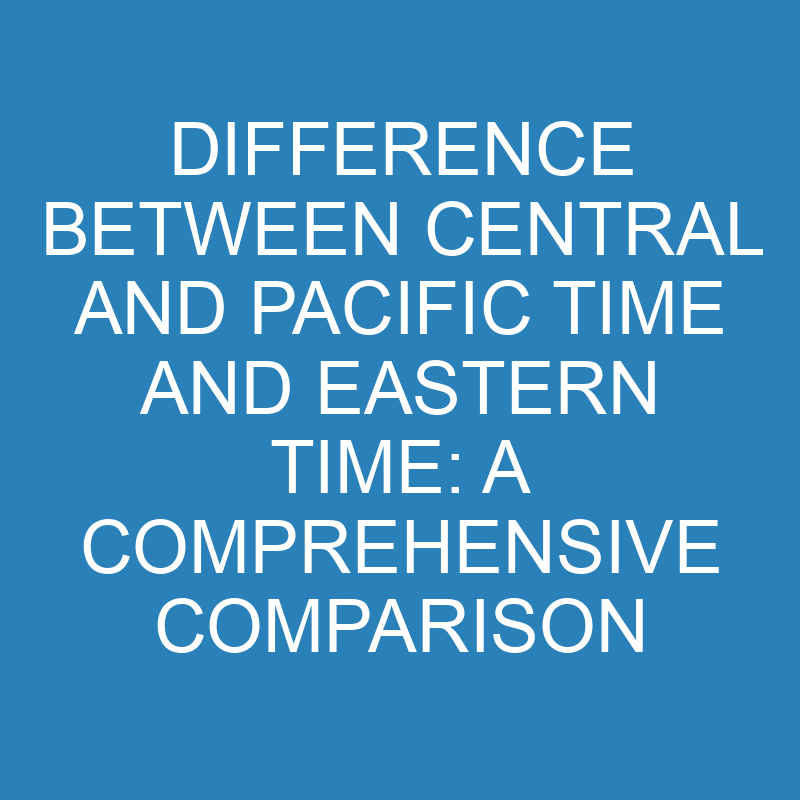
Are you curious about the difference between Central Time, Pacific Time, and Eastern Time? Well, let me break it down for you. These time zones are used in different regions of the United States and can affect everything from travel plans to scheduling appointments. So, let’s dive into the specifics.
Central Time (CT) is observed in states such as Texas, Illinois, and Missouri. It is 6 hours behind Coordinated Universal Time (UTC-6). This means that when it’s noon in CT, it’s already 1 p.m. on the East Coast in Eastern Time (ET). CT is commonly referred to as “Central Standard Time” (CST) during standard time and “Central Daylight Time” (CDT) during daylight saving time.
Moving westward, we reach Pacific Time (PT), which covers states like California, Washington, and Oregon. PT is 8 hours behind UTC-8 during standard time and UTC-7 during daylight saving time. So if it’s noon in PT, it’s already 3 p.m. on the East Coast in ET. Several major cities including Los Angeles and Seattle operate on this time zone.
Lastly, we have Eastern Time (ET), which includes populous areas such as New York City, Atlanta, and Miami. ET follows UTC-5 during standard time and shifts to UTC-4 during daylight saving time. If it’s noon in ET, it will be 11 a.m. in CT and 9 a.m. in PT.
Understanding these differences can help ensure that you’re always aware of the correct local time when planning trips or scheduling meetings across different regions of the United States.
Understanding Time Zones
Time zones play a crucial role in ensuring that clocks around the world are synchronized, allowing for efficient coordination and communication between different regions. Let’s delve into the basics of time zones and how they relate to Central Time (CT), Pacific Time (PT), and Eastern Time (ET).
- What are Time Zones?
Time zones are geographical regions that follow a standard time offset from Coordinated Universal Time (UTC). They help us keep track of time in different parts of the world by dividing the Earth into 24 sections, each representing one hour. - The Impact of Longitude
The primary factor influencing time zone boundaries is longitude. As we move east or west across meridians, every 15 degrees represents a one-hour difference in local time. This division allows for consistency within each zone while accommodating varying daylight hours throughout the year. - Central Time (CT)
Central Time is observed in several regions across North America, including parts of Canada, Mexico, and most notably, the central United States. CT is commonly used by major cities such as Chicago, Dallas, and Houston. - Pacific Time (PT)
Pacific Time covers much of the western coastal areas of North America, including California, Oregon, Washington State, as well as parts of Canada like British Columbia. PT is associated with cities like Los Angeles, San Francisco, and Seattle. - Eastern Time (ET)
Eastern Time encompasses many populous areas on the eastern seaboard of North America, stretching from Florida to New York and beyond. ET is employed by cities such as New York City, Miami, Atlanta, and Toronto in Canada.
It’s important to note that Daylight Saving Time may affect these time zones differently throughout the year when clocks are adjusted forward or backward by one hour to maximize daylight during specific months.
Understanding time zones helps us coordinate global activities efficiently while keeping track of appointments across different regions accurately. Whether you’re scheduling a business call, planning a trip, or simply staying connected with loved ones in different time zones, being aware of these variations can make a significant difference.
Now that we have a better understanding of the basics, let’s explore the specific differences between Central Time, Pacific Time, and Eastern Time in the following sections.
Central Standard Time (CST)
Let’s dive into the fascinating world of Central Standard Time (CST). This time zone is one of the six principal time zones in the United States and is observed in several states, including Texas, Illinois, and Minnesota. So, if you find yourself in these regions or need to coordinate with someone residing there, understanding CST becomes essential.
CST is six hours behind Coordinated Universal Time (UTC-6:00). This means that when it’s noon UTC, it will be 6:00 AM CST. It’s important to note that CST does not observe Daylight Saving Time. Instead, it follows Central Daylight Time (CDT) during the summer months.
If you’re wondering about major cities that adhere to Central Standard Time, look no further than Chicago! The Windy City operates on this time zone throughout the year. Other prominent cities include Dallas and Houston in Texas. Whether you’re planning a trip or scheduling a conference call with colleagues from these areas, knowing the local time can save you from any confusion.
It’s worth mentioning that CST also affects television schedules and live broadcasts across different networks. If there’s a program airing at 8:00 PM CST, viewers tuning in from other parts of the country will need to adjust their watches accordingly.
In summary, Central Standard Time (CST) is an important time zone observed by various states within the United States. It adheres to UTC-6:00 throughout the year and does not observe Daylight Saving Time. Understanding this time zone can greatly assist with coordination and avoid any scheduling mishaps when interacting with individuals or planning activities within these regions.
Post Contents
Pacific Standard Time (PST)
When it comes to time zones in the United States, Pacific Standard Time (PST) holds its own significance. Situated on the west coast, PST is observed in several states including California, Oregon, Washington, Nevada, and parts of Idaho. In this section, we’ll delve into what makes Pacific Standard Time unique and explore its differences from other time zones.
Geographical Scope
Pacific Standard Time covers a vast region along the western edge of North America. It stretches from the Canadian border all the way down to the Mexican border. This means that major cities like Los Angeles, San Francisco, Seattle, and Vancouver all fall within this time zone. So if you find yourself planning a trip or needing to coordinate with someone in these areas, knowing about PST is essential.
UTC Offset
One of the key features that distinguishes Pacific Standard Time is its UTC offset. UTC stands for Coordinated Universal Time and serves as a global standard for measuring time across different regions. The UTC offset for PST is -8 hours during standard time periods. This means that when it’s 12:00 PM Coordinated Universal Time (UTC), it will be 4:00 AM in Pacific Standard Time.
Daylight Saving Time
Like many other regions in North America, Pacific Standard Time observes Daylight Saving Time (DST). During DST periods, which typically start on the second Sunday of March and end on the first Sunday of November each year, clocks are set one hour ahead to make better use of daylight during longer summer days. When DST is in effect, Pacific Standard Time switches over to Pacific Daylight Time (PDT).
Notable Observances
Being home to significant urban centers and tourist attractions along the west coast, Pacific Standard Time plays host to various events and observances throughout the year. From music festivals like Coachella in California to cultural celebrations such as Seafair in Seattle, PST offers a vibrant and diverse cultural scene. It’s important to keep these notable observances in mind when planning activities or attending events in the region.
As we explore the intricacies of time zones, Pacific Standard Time emerges as a key player on the west coast of North America. With its unique geographical scope, UTC offset, and observance of Daylight Saving Time, PST distinguishes itself from other time zones across the country. So whether you’re scheduling meetings or simply wanting to stay informed about specific regions along the Pacific coast, understanding Pacific Standard Time is certainly valuable.
Eastern Standard Time (EST)
Let’s dive into the world of Eastern Standard Time (EST). This time zone is used in several regions of North America, including parts of the United States and Canada. It is observed during the non-daylight saving period, typically from fall to spring.
In the United States, Eastern Standard Time covers a significant portion of the country, including states such as New York, Florida, Pennsylvania, and many more. It is important to note that some states within this time zone may choose to observe daylight saving time during certain periods, shifting their clocks forward by one hour.
One notable characteristic of Eastern Standard Time is its offset from Coordinated Universal Time (UTC-5:00). This means that when it’s 12:00 PM UTC, it’s 7:00 AM EST. Understanding this offset can be particularly useful when planning meetings or coordinating activities across different time zones.
When it comes to business and communication on an international scale, being aware of Eastern Standard Time allows individuals to effectively collaborate with colleagues or partners located in this region. By taking into account the time difference and adjusting schedules accordingly, professionals can ensure smooth teamwork and efficient interactions.
In conclusion, Eastern Standard Time (EST) plays a crucial role in various parts of North America. Its observance affects not only daily life but also business operations within this extensive region. Being knowledgeable about these time zones enables better coordination and synchronization across different locations. So whether you’re scheduling a meeting or catching a flight, understanding EST will undoubtedly prove beneficial.
Conclusion
To wrap things up, here’s a summary of the key points we’ve covered regarding the difference between Central Time (CT), Pacific Time (PT), and Eastern Time (ET):
- Time Zone Variations:
- Geographical Coverage:
- Daylight Saving Time:
- Business Hours and TV Programming:
- Travel Considerations:
In conclusion, understanding the differences between Central Time, Pacific Time, and Eastern
Time can help individuals better manage their schedules, coordinate with people in different regions, and avoid any potential timing mishaps. So whether you’re planning a business call or catching your favorite TV show live, being aware of these time zone distinctions will ensure that you’re always on time.






